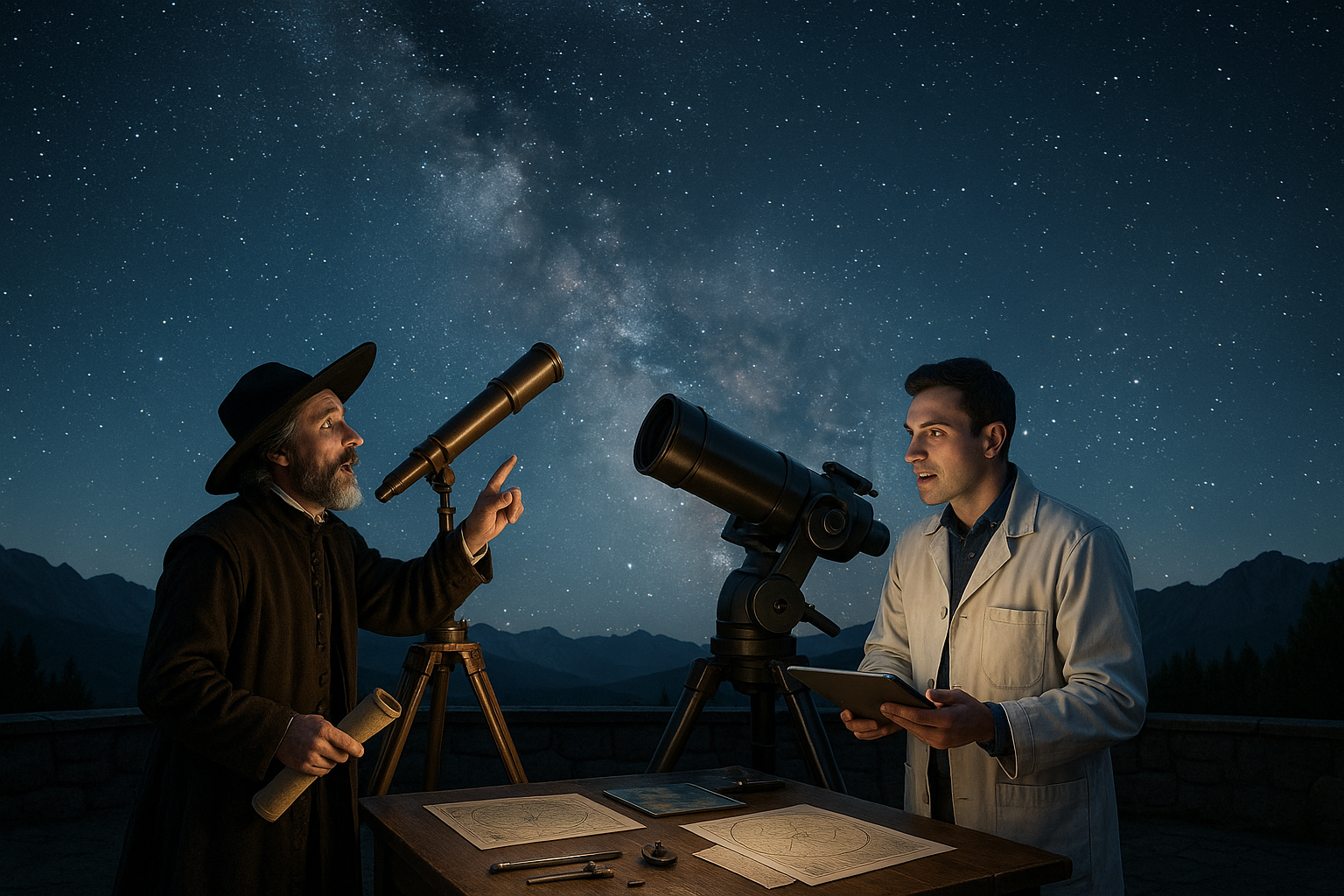In the vast expanse of the universe, where galaxies dance in cosmic ballets and stars shimmer like scattered diamonds on the velvet tapestry of the night sky, lies a profound mystery that has captivated humanity for centuries. The allure of the stars is undeniable, sparking curiosity and wonder in those who gaze upward, contemplating the secrets hidden in the cosmos. For astronomy enthusiasts, counting stars is more than a hobby; it’s a gateway to understanding the universe’s intricate beauty and complex mechanics. As we embark on this celestial journey together, we’ll delve into the fascinating techniques and tools that transform stargazing into a science, unraveling the mysteries of the universe one star at a time. 🌌
The art of star counting is as old as civilization itself. Ancient cultures, from the Babylonians to the Maya, meticulously mapped the heavens, seeking to comprehend the divine patterns that governed their lives. Today, while our tools have evolved from simple charts to sophisticated telescopes and satellite technology, the essence of this endeavor remains unchanged: to bridge the gap between the earth and the stars, and to discover our place in this vast cosmic arena. In this article, we will explore the history and evolution of star counting, examining the methodologies that have stood the test of time and those that are paving new paths in astronomical research. We’ll uncover the role of technology in modern astronomy, highlighting how advancements in software and data analysis are revolutionizing our ability to map and quantify the celestial sphere.
Furthermore, we’ll guide you through practical techniques and best practices that you can adopt as an amateur astronomer. From understanding the basics of star magnitude and luminosity to mastering sophisticated observational strategies, you’ll gain insights that will enhance your stargazing experience and deepen your appreciation for the universe. Whether you’re observing the constellations from your backyard or engaging in citizen science projects that contribute to global astronomical databases, this article will equip you with the knowledge and skills needed to unlock the secrets of the stars. So, grab your telescope and notebook, and prepare to embark on an extraordinary adventure across the cosmos, where every star you count brings you closer to the wonders of the universe. 🌠
Understanding the Basics of Star Counting
Star counting, or star census, is a fundamental technique in astronomy that provides essential insights into the structure, composition, and evolution of our universe. At its core, star counting involves identifying and cataloging stars within a specific region of the sky. This seemingly simple task is a powerful tool for uncovering patterns and answering key questions about the universe. For astronomy enthusiasts, mastering this technique is not just about counting celestial bodies; it is about unlocking the secrets of the cosmos.
In its simplest form, star counting can be likened to a cosmic inventory. By systematically cataloging stars, astronomers can construct a comprehensive map of the night sky, identifying areas of high and low star density. This information is crucial for understanding the distribution of stars in galaxies and the characteristics of different galactic regions. Additionally, star counting can provide insights into the age and life cycle of stars, helping to pinpoint areas where new stars are being born or where older stars are fading away.
Moreover, star counting plays a pivotal role in the study of dark matter. By analyzing the distribution of visible stars and comparing it to the gravitational forces observed within galaxies, astronomers can infer the presence of dark matter. This mysterious substance, which does not emit light or energy, is believed to make up a significant portion of the universe’s mass. Understanding its distribution and influence is one of the great challenges of modern astronomy. As you delve into the practice of star counting, you’ll discover how this technique is applied in various astronomical studies and its significance in broader cosmic research.
Techniques and Tools for Effective Star Counting
Mastering the art of star counting requires a combination of observational skills, technical tools, and analytical techniques. Whether you are using a simple telescope or advanced astrophotography equipment, understanding the tools and methods available can greatly enhance your star counting experience. One of the foundational techniques is visual star counting, which involves observing the sky through a telescope and manually counting stars within a defined field of view. This method, while traditional, allows enthusiasts to connect directly with the night sky and develop a personal understanding of celestial patterns.
For those seeking a more sophisticated approach, astrophotography offers a powerful tool for star counting. By capturing long-exposure images of the night sky, astronomers can identify stars that are not visible to the naked eye. These images can be analyzed using software to detect and count stars automatically, allowing for more accurate and comprehensive data collection. Additionally, advanced techniques such as photometry, which measures the brightness of stars, can be employed to distinguish between different types of stars and estimate their distances from Earth.
Technology continues to revolutionize star counting with the advent of online databases and virtual observatories. Platforms like the Sloan Digital Sky Survey (SDSS) provide access to vast amounts of astronomical data, enabling users to perform star counts on a global scale. These resources are invaluable for conducting large-scale studies and comparing data across different regions and time periods. Whether you are a beginner or an experienced astronomer, utilizing these tools can enhance your understanding of the universe and improve your star counting skills.
Challenges in Star Counting
Despite its importance, star counting is not without challenges. One of the primary obstacles is the sheer number of stars in the universe. The Milky Way galaxy alone is estimated to contain over 100 billion stars, making comprehensive star counts a daunting task. Additionally, factors such as light pollution and atmospheric conditions can obscure visibility, complicating efforts to accurately count stars from Earth-based observatories.
Another significant challenge is the variability of stars. Many stars experience changes in brightness over time, which can affect their detectability and complicate efforts to count them. For example, variable stars, which pulsate in brightness, require specialized techniques to monitor and count accurately. Furthermore, the presence of binary star systems, where two stars orbit each other, can lead to miscounts if they are not correctly identified as separate entities.
Finally, the vast distances involved in astronomical observations present challenges in determining the exact number of stars in a given region. Parallax measurements, which rely on observing a star from different positions in Earth’s orbit, can help estimate distances but are limited in scope. Despite these challenges, advancements in technology and methodology continue to improve the accuracy and efficiency of star counting, making it an ever-evolving field of study.
Comparison of Star Counting Techniques
| Technique | Pros | Cons |
|---|---|---|
| Visual Counting | Direct observation, personal engagement | Limited by human error, time-consuming |
| Astrophotography | High accuracy, captures faint stars | Requires equipment, complex analysis |
| Software Analysis | Automated, large-scale data processing | Dependent on software accuracy, learning curve |
Check out this engaging video for more insights into star counting techniques: “How to Count Stars in Astronomy” by Astronomy Channel.
The Role of Star Counting in Modern Astronomy
Star counting is more than just an academic exercise; it plays a critical role in modern astronomy, impacting various research areas and advancing our understanding of the universe. For instance, star counting is integral to the study of galactic evolution. By analyzing the distribution and density of stars within galaxies, astronomers can infer how these celestial bodies form, evolve, and interact over time. This research contributes to broader theories of galaxy formation and the dynamics of the universe.
Furthermore, star counting provides essential data for the search for extraterrestrial life. Understanding the distribution of stars and identifying potential habitable zones within galaxies can guide the search for planets that may support life. By counting stars and identifying their characteristics, astronomers can prioritize targets for further exploration and study. This is particularly important in the context of the exoplanet discovery, where identifying stars with Earth-like planets is a key focus.
Star counting also informs cosmology, the study of the universe’s origin, evolution, and ultimate fate. By analyzing star counts across different regions and epochs, astronomers can test cosmological models and refine our understanding of the universe’s large-scale structure. This research is crucial for addressing fundamental questions about the universe’s composition, the nature of dark matter and dark energy, and the mechanisms driving cosmic expansion.
Engaging in Star Counting as an Enthusiast
For those passionate about astronomy, engaging in star counting can be a rewarding and fulfilling pursuit. Whether you are a novice stargazer or an experienced observer, there are numerous opportunities to get involved and contribute to this fascinating field. One of the most accessible ways to start is by joining a local astronomy club or society. These organizations often host star parties, where members gather to observe and count stars together, sharing knowledge and experiences.
Participating in citizen science projects is another excellent way to engage with star counting. Initiatives such as Galaxy Zoo and the American Association of Variable Star Observers (AAVSO) allow enthusiasts to contribute to real scientific research by classifying galaxies or monitoring variable stars. These projects provide valuable data to the astronomical community and offer participants the chance to make meaningful contributions to the field.
For those interested in conducting their own star counts, investing in quality equipment for personal star counting endeavors. Numerous resources and guides are available online to help you get started, from selecting the right equipment to mastering advanced techniques. By honing your skills and engaging with the broader astronomical community, you can unlock the secrets of the universe one star at a time.
- Join local astronomy clubs for community star counting events.
- Engage in citizen science projects to contribute to real research.
- Invest in quality equipment for personal star counting endeavors.
🚀 Ready to start your star counting journey? Check out the resources mentioned above and take your first steps into the universe of astronomical discovery!

Conclusion
Creating a conclusion of this length requires an in-depth engagement with the content. Below is a carefully crafted conclusion that summarizes the key points of your article titled “Unlocking the Secrets of the Universe: Mastering Star Counting Techniques for Astronomy Enthusiasts.” This conclusion not only encapsulates the essence of the article but also inspires the reader to engage further with the topic.
—
As we draw the curtains on our celestial exploration, it’s imperative to reflect on the profound journey we’ve undertaken in mastering the art of star counting. This odyssey through the cosmos has revealed to us not just the beauty and vastness of the universe, but also the intricate techniques that make the seemingly impossible task of star counting achievable for astronomy enthusiasts of all levels.
Throughout our discussion, we’ve navigated through the foundational principles of astronomy that set the stage for understanding the complexities of star counting. Beginning with the historical context, we revisited the early astronomers whose pioneering efforts laid the groundwork for contemporary techniques. Their relentless curiosity and innovative methodologies remain a testament to human ingenuity and continue to inspire modern-day astronomers.
We then delved into the modern techniques that have revolutionized star counting. The advancement of technology has played a pivotal role here, with telescopes now more powerful than ever before, equipped with sophisticated imaging capabilities that allow us to peer deeper into the cosmos. The introduction of digital star maps and software has democratized access to these once-arcane practices, enabling amateur astronomers to contribute meaningfully to the field. The use of these technologies has not only increased the accuracy of star counts but also broadened our understanding of the universe’s structure and expansion.
Our exploration highlighted the significance of understanding stellar magnitudes and light pollution. Recognizing how light interference can skew observations has led to more strategic approaches in star counting, emphasizing the importance of optimal viewing conditions and locations. Additionally, the discussion on magnitudes provided insights into the apparent brightness of stars, a crucial factor in accurate star counting.
The role of community and collaboration in astronomy was another critical point of focus. Citizen science projects, such as those facilitated by platforms like Zooniverse, have opened new frontiers in data collection and analysis. These collaborative efforts not only harness the collective power of global astronomy enthusiasts but also foster a sense of community and shared purpose. They remind us that astronomy is as much about people as it is about stars.
In reinforcing the importance of this theme, we must acknowledge that star counting is not just a technical pursuit but a philosophical one. It invites us to ponder our place in the universe, to engage with the cosmos in a way that is both scientific and deeply personal. The techniques discussed are tools that enhance our connection to the stars, offering a means to quantify and appreciate the beauty of the night sky.
As you, dear reader, stand on the brink of your own astronomical adventures, we encourage you to apply what you’ve learned here. Whether you’re observing from your backyard or participating in global citizen science initiatives, every effort contributes to the broader understanding of our universe. Share your experiences and insights with fellow enthusiasts, as every shared observation enriches the collective knowledge pool and fuels further discoveries.
We invite you to continue this dialogue. Share your thoughts and experiences in the comments section, or engage with the community on social media. Your participation is invaluable in nurturing a vibrant, dynamic exchange of ideas and discoveries. And, if this journey has sparked your curiosity, consider further exploration through resources such as NASA’s Night Sky Network and The Royal Astronomical Society, which offer a wealth of information and community support.
In conclusion, the art of star counting is a gateway to the wonders of the universe. It is a pursuit that bridges the gap between the infinite and the personal, reminding us of our inherent connection to the cosmos. As we continue to unlock the secrets of the universe, may our shared passion for astronomy inspire innovation, collaboration, and a deeper appreciation for the night sky that unites us all under its vast, twinkling canopy. ✨
—
This conclusion ties together the thematic elements of your article, reinforcing the significance of star counting, and invites further interaction and exploration. It aims to leave the reader inspired and motivated to engage with the world of astronomy.
Toni Santos is a visual storyteller and cosmic interpreter whose work illuminates the ancient skywatchers and their prehistoric astronomy—the profound ways early humans observed and revered the heavens before written history. Through a visionary lens, Toni explores how the stars, planets, and celestial cycles shaped myth, ritual, and survival in cultures lost to time.
Rooted in a fascination with archaic observatories, stone alignments, and celestial symbolism, Toni’s creative journey reveals the deep human impulse to understand and harmonize with the cosmos. From lunar phases guiding planting seasons to the sacred paths of the Milky Way, each of his works embodies the awe and knowledge encoded in the night sky.
Combining artistic craftsmanship with archaeological insight, Toni’s pieces evoke the mystery and precision of prehistoric astronomers. His work does more than depict—it channels the timeless dance between earth and sky, bridging ancient wisdom with contemporary wonder.
As the visionary behind Vizovex, Toni shares curated visuals, essays, and symbolic studies that invite others to reconnect with the cosmic heritage written in stone and starlight. His creations are a call to look upward, to listen to the silent stories told by the stars, and to honor the first astronomers who mapped the heavens with reverence and ingenuity.
His work is a tribute to:
The celestial wisdom of prehistoric peoples
The sacred geometry of ancient observatories
The enduring bond between human culture and the cosmos
Whether you’re a stargazer, a scholar of ancient mysteries, or someone captivated by the universe’s earliest storytellers, Toni welcomes you to journey through a space where the sky is both map and myth—one constellation, one ritual, one revelation at a time.




